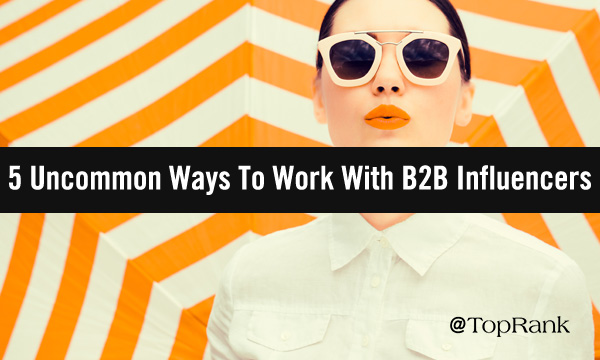
 What are some uncommon ways B2B marketers can successfully work with influencers? One of the many advantages of working with subject matter experts (SMEs) who are influential in their industry is the sheer variety of ways that marketers can collaborate to build a mutually beneficial partnership. While we’ve explored many of the traditional ways B2B marketers often work with influencers, we wanted to take a look at a few of the unusual ways collaboration is taking place. Let’s dive right in, with examples from both SMEs and marketers who’ve implemented uncommon takes on the B2B influencer partnership that can help inspire your own influencer programs.
What are some uncommon ways B2B marketers can successfully work with influencers? One of the many advantages of working with subject matter experts (SMEs) who are influential in their industry is the sheer variety of ways that marketers can collaborate to build a mutually beneficial partnership. While we’ve explored many of the traditional ways B2B marketers often work with influencers, we wanted to take a look at a few of the unusual ways collaboration is taking place. Let’s dive right in, with examples from both SMEs and marketers who’ve implemented uncommon takes on the B2B influencer partnership that can help inspire your own influencer programs.
1 — From Influencer to Long-Term Friendship
 Christopher Penn, co-founder and chief data scientist at Trust Insights, has found that an influencer partnership can on occasion lead to something bigger than the sum of its parts. “Uncommon experience? Becoming great friends with one of the folks who was originally just doing outreach,” Christopher shared. “There’s always a bit of a power imbalance in any kind of influencer situation, especially in cases where someone is asking for help and there isn’t a tangible exchange of value — like payment,” Christopher explained. “But occasionally you run into someone that’s just a solid, good human being, and the commercial relationship evolves into an actual friendship. Rare, but delightful,” Christopher noted. Successful B2B influencer marketing programs are often built on long-term professional relationships that find brands and SMEs working together and helping one another over the long haul, giving rise to always-on efforts that gain strength as years of shared experiences and successes accumulate. Finding friendship is a bonus that can sometimes happen when working with influencer programs, and is certainly one to treasure as Christopher shared. [bctt tweet="“Occasionally you run into someone that’s just a solid, good human being, and the commercial relationship evolves into an actual friendship. Rare, but delightful.” — Christopher Penn @cspenn" username="toprank"]
Christopher Penn, co-founder and chief data scientist at Trust Insights, has found that an influencer partnership can on occasion lead to something bigger than the sum of its parts. “Uncommon experience? Becoming great friends with one of the folks who was originally just doing outreach,” Christopher shared. “There’s always a bit of a power imbalance in any kind of influencer situation, especially in cases where someone is asking for help and there isn’t a tangible exchange of value — like payment,” Christopher explained. “But occasionally you run into someone that’s just a solid, good human being, and the commercial relationship evolves into an actual friendship. Rare, but delightful,” Christopher noted. Successful B2B influencer marketing programs are often built on long-term professional relationships that find brands and SMEs working together and helping one another over the long haul, giving rise to always-on efforts that gain strength as years of shared experiences and successes accumulate. Finding friendship is a bonus that can sometimes happen when working with influencer programs, and is certainly one to treasure as Christopher shared. [bctt tweet="“Occasionally you run into someone that’s just a solid, good human being, and the commercial relationship evolves into an actual friendship. Rare, but delightful.” — Christopher Penn @cspenn" username="toprank"]
2 — Building Trust with Pre-Release Influencer Briefings
 For Michaela Underdahl, marketing lead at customer relationship management software firm Nimble, there are a variety of uncommon tactics that can be used when working with industry influencers. “One of our main goals at Nimble is to turn the influencers that we work with into power users and evangelists,” Michaela said. “So, every time we are launching a new feature, we brief our influencers prior to the release date and request quotes describing the benefits of the feature to them. Depending on the type of the influencer, we use the quotes in various different ways,” Michaela explained. “Some of the more common ways are press releases and blog posts, but we also create social graphics and use the quotes to reach out to additional influencers and press. This helps us open new doors as people recognize these influencers and are more likely to start working with us since they know we already work with people they know, like and trust,” Michaela shared. This trust and the variety of ways it can be nurtured when working with SMEs is another example of the power of influencer marketing to go beyond traditional content or search marketing initiatives, as we explored recently in "Trust and the Search for Answers: How Influence Optimizes SEO Performance." Empowering evangelists as Michaela noted can lead to stronger influencer relationships that benefit both brands and industry experts. [bctt tweet="“One of our main goals at Nimble is to turn the influencers that we work with into power users and evangelists.” — Michaela Underdahl @MichaUnderdahl" username="toprank"]
For Michaela Underdahl, marketing lead at customer relationship management software firm Nimble, there are a variety of uncommon tactics that can be used when working with industry influencers. “One of our main goals at Nimble is to turn the influencers that we work with into power users and evangelists,” Michaela said. “So, every time we are launching a new feature, we brief our influencers prior to the release date and request quotes describing the benefits of the feature to them. Depending on the type of the influencer, we use the quotes in various different ways,” Michaela explained. “Some of the more common ways are press releases and blog posts, but we also create social graphics and use the quotes to reach out to additional influencers and press. This helps us open new doors as people recognize these influencers and are more likely to start working with us since they know we already work with people they know, like and trust,” Michaela shared. This trust and the variety of ways it can be nurtured when working with SMEs is another example of the power of influencer marketing to go beyond traditional content or search marketing initiatives, as we explored recently in "Trust and the Search for Answers: How Influence Optimizes SEO Performance." Empowering evangelists as Michaela noted can lead to stronger influencer relationships that benefit both brands and industry experts. [bctt tweet="“One of our main goals at Nimble is to turn the influencers that we work with into power users and evangelists.” — Michaela Underdahl @MichaUnderdahl" username="toprank"]
3 — Discovering New Influencers In Unusual Social Hangouts
 B2B influencer marketing continues to evolve, and SMEs in some industries aren’t always going to be found solely on the traditional social media platforms of LinkedIn*, Twitter, Facebook, and Instagram. Many industries have attracted an infusion of newly-minted marketing professionals, and the SMEs they consider influential may frequent an entirely different set of online communication platforms, which could be any of the following or others:
B2B influencer marketing continues to evolve, and SMEs in some industries aren’t always going to be found solely on the traditional social media platforms of LinkedIn*, Twitter, Facebook, and Instagram. Many industries have attracted an infusion of newly-minted marketing professionals, and the SMEs they consider influential may frequent an entirely different set of online communication platforms, which could be any of the following or others:
- Clubhouse
- Twitter Spaces
- TikTok
- Spotify Greenroom
- Facebook Live Audio Rooms
- Caffeine
- Twitter Blue
- MeWe
- Twitch
- How B2B Marketing Influencers Are Finding Success On New Social Channels
- On-Target: What’s New With Twitter For B2B Marketers In 2021
- How B2B Brands Can Boost Confidence in Livestream Video, Podcast and Clubhouse Marketing
4 — Working Together To Drive Industry Knowledge
 Perhaps even more than in B2C marketing, B2B influencers have increasingly formed mostly private groups that serve as communication tools for refining and driving the long-term success of influencer marketing. Sometimes driving industry knowledge and empowering influencers are also tackled by more public groups, such as the popular Adobe Insiders program. “Working with a small group of influencers can be a great place to start, but that small group should be backed by a much larger list of researched candidate influencers. As relationships develop through the course of different collaborations, B2B marketers will refine and find the right influencers. A VIP group of influencers might be created as Adobe has with its 60+ Adobe Insiders being activated at individual, small group or large group levels depending on the situation,” our CEO and co-founder Lee Odden noted recently in “B2B Influencer Marketing Strategy: 5 Questions to Ask First.” The Adobe Insiders program is a diverse group of over 60 influencers that includes leading executives, industry leaders, major media correspondents, contributing journalists, and technology pioneers — including Lee. Managing the B2B Adobe Insiders program is Rani Mani, head of employee advocacy at Adobe. Rani shared her insight into the program and how it drives industry knowledge and more in her in-depth interview for our Inside B2B Influence show, which is available at “Inside Influence 1: Rani Mani from Adobe on the B2B Influencer Marketing Advantage.” [bctt tweet="“I think we’ll see a lot more influencers standing up for their creative freedom and creative license and I think we’ll see less prescriptive micromanagement from brands.” — Rani Mani @ranimani0707" username="toprank"]
Perhaps even more than in B2C marketing, B2B influencers have increasingly formed mostly private groups that serve as communication tools for refining and driving the long-term success of influencer marketing. Sometimes driving industry knowledge and empowering influencers are also tackled by more public groups, such as the popular Adobe Insiders program. “Working with a small group of influencers can be a great place to start, but that small group should be backed by a much larger list of researched candidate influencers. As relationships develop through the course of different collaborations, B2B marketers will refine and find the right influencers. A VIP group of influencers might be created as Adobe has with its 60+ Adobe Insiders being activated at individual, small group or large group levels depending on the situation,” our CEO and co-founder Lee Odden noted recently in “B2B Influencer Marketing Strategy: 5 Questions to Ask First.” The Adobe Insiders program is a diverse group of over 60 influencers that includes leading executives, industry leaders, major media correspondents, contributing journalists, and technology pioneers — including Lee. Managing the B2B Adobe Insiders program is Rani Mani, head of employee advocacy at Adobe. Rani shared her insight into the program and how it drives industry knowledge and more in her in-depth interview for our Inside B2B Influence show, which is available at “Inside Influence 1: Rani Mani from Adobe on the B2B Influencer Marketing Advantage.” [bctt tweet="“I think we’ll see a lot more influencers standing up for their creative freedom and creative license and I think we’ll see less prescriptive micromanagement from brands.” — Rani Mani @ranimani0707" username="toprank"]
5 — Spark Interest by Mentoring New B2B Influencers
 By mentoring the next generations of marketing influencers, you’ll not only help new SMEs develop, but also continue your own lifelong learning. Influencer marketing is a two-way street when it comes to mentoring opportunities. “I think it’s really important that people seek out a person who is going to be a champion for them if they want to advance and grow their career,” Jen Holtvluwer, chief marketing officer at Spirion shared in our “Inside Influence 5: Jen Holtvluwer from Spiron on Award Winning B2B Influencer Marketing.” “I’ve had so many that I still keep in touch with today that have been that champion for my cause. So I think it’s really important to not to do it alone and make sure you put in the time and that your time is noticed. And make sure that you’re marketing yourself to the right champion in the business. Then they’ll stay with you and refer you as other opportunities come up,” Jen explained. We can do a great service to future generations by sharing our insight with aspiring young B2B influencers. If we can spark an interest by mentoring a younger colleague, client or associate, we’ll contribute to a future of marketing that is more robust with your own personal knowledge passed along to the next generation. We can do this by inspiring and mentoring young influencer talent by imparting your own passion for B2B marketing, as Peggy Smedley, editorial director and president at Specialty Publishing Media, shared with us in “B2B Influencer Marketing Advice from 9 Top B2B Influencers.” “As influencers we are here to serve the mission and [know] that our influence on people comes from our ability to be a role model. We need to be very mindful about what we say and how we say it. We are always leaders and mentors and we need to focus on the needs of others first because we have been tasked with leading others. We always need to serve others and by doing that we are doing the best for ourselves,” Peggy shared. [bctt tweet="“We are always leaders and mentors and we need to focus on the needs of others first because we have been tasked with leading others.” — Peggy Smedley @ConnectedWMag" username="toprank"]
By mentoring the next generations of marketing influencers, you’ll not only help new SMEs develop, but also continue your own lifelong learning. Influencer marketing is a two-way street when it comes to mentoring opportunities. “I think it’s really important that people seek out a person who is going to be a champion for them if they want to advance and grow their career,” Jen Holtvluwer, chief marketing officer at Spirion shared in our “Inside Influence 5: Jen Holtvluwer from Spiron on Award Winning B2B Influencer Marketing.” “I’ve had so many that I still keep in touch with today that have been that champion for my cause. So I think it’s really important to not to do it alone and make sure you put in the time and that your time is noticed. And make sure that you’re marketing yourself to the right champion in the business. Then they’ll stay with you and refer you as other opportunities come up,” Jen explained. We can do a great service to future generations by sharing our insight with aspiring young B2B influencers. If we can spark an interest by mentoring a younger colleague, client or associate, we’ll contribute to a future of marketing that is more robust with your own personal knowledge passed along to the next generation. We can do this by inspiring and mentoring young influencer talent by imparting your own passion for B2B marketing, as Peggy Smedley, editorial director and president at Specialty Publishing Media, shared with us in “B2B Influencer Marketing Advice from 9 Top B2B Influencers.” “As influencers we are here to serve the mission and [know] that our influence on people comes from our ability to be a role model. We need to be very mindful about what we say and how we say it. We are always leaders and mentors and we need to focus on the needs of others first because we have been tasked with leading others. We always need to serve others and by doing that we are doing the best for ourselves,” Peggy shared. [bctt tweet="“We are always leaders and mentors and we need to focus on the needs of others first because we have been tasked with leading others.” — Peggy Smedley @ConnectedWMag" username="toprank"]
Taming Your Uncharted Influencer Waters
via GIPHY By making the leap from influencer to long-term friendship, building trust by sharing pre-campaign briefings, tapping into unusual social hangouts, using influencer groups to drive industry knowledge, and mentoring future influencers, your own B2B influencer marketing program can benefit substantially from these uncommon tactics. These five are only the tip of the influencer marketing iceberg, however, as the power of influence is expansive and only expected to increase as we make the push to 2022. To learn more about the power of influence in B2B marketing, be sure to catch the new season of our Inside B2B Influence show, featuring in-depth video and podcast interviews with the top B2B influencers working with the world's biggest B2B brands. The season kicked off with Ann Handley of MarketingProfs in "Inside B2B Influence 14: Ann Handley of MarketingProfs on Content Marketing and Influence." Creating award-winning B2B marketing with an artful mixture of influence takes considerable time and effort, which is why many firms choose to work with a top digital marketing agency such as TopRank Marketing. Contact us today and let us know how we can help, as we’ve done for businesses ranging from LinkedIn, Dell and 3M to Adobe, Oracle, monday.com and others. * LinkedIn is a TopRank Marketing client.The post Mindful Marketing: 5 Uncommon Ways To Work With B2B Influencers appeared first on B2B Marketing Blog - TopRank®.
Article Source: http://bathseoexpert.blogspot.com/2021/06/mindful-marketing-5-uncommon-ways-to.html
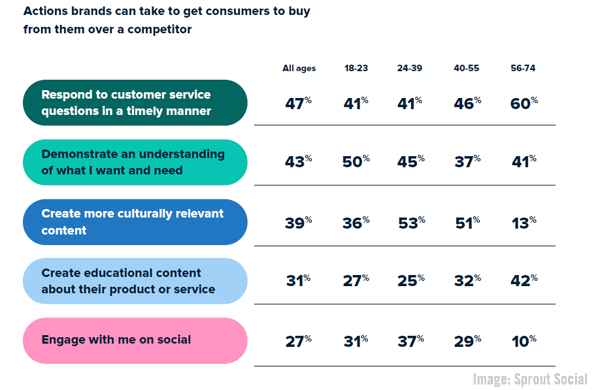
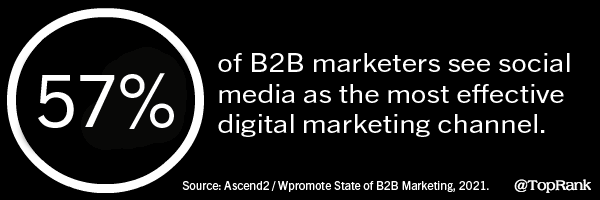 2021 State of B2B Digital Marketing [Report] The number one digital marketing trend B2B brands are prioritizing is the utilization of new social platforms, while 57 percent of marketers said that social media was seen as the area of digital customer experience that had the most impact on overall strategic success, according to newly-released B2B digital marketing report data.
2021 State of B2B Digital Marketing [Report] The number one digital marketing trend B2B brands are prioritizing is the utilization of new social platforms, while 57 percent of marketers said that social media was seen as the area of digital customer experience that had the most impact on overall strategic success, according to newly-released B2B digital marketing report data.  A lighthearted look at the “customer lifetime value” by Marketoonist Tom Fishburne —
A lighthearted look at the “customer lifetime value” by Marketoonist Tom Fishburne — 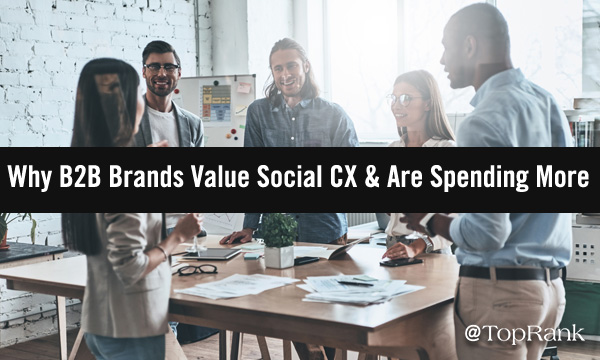
 “88 percent of marketers agree their social strategy positively influences their bottom line,” the research concludes. The value of social data has generally increased over time, and the new Sprout Social study bears this out, revealing that 47 percent of marketers consider social a resource that influences strategy for multiple organizational teams, while 46 still see it as strictly a marketing resource, with eight percent viewing it as an organization-wide resource for business intelligence. Something as seemingly simple as responding quickly to customer questions can be very important in brand purchase decisions. 47 percent of consumers said that responding to customer service questions in a timely manner was the top way brands could get them to buy and forgo competitors. Nearly as important among consumers were brands that demonstrate an understanding of what consumers want and need. “Nine out of 10 consumers will buy from brands they follow on social, while 86% will choose that brand over a competitor,” the Sprout Social report data showed. Given the importance customers place on speedy response times from brands, it’s easy to see how the new Sprout Social data indicated that “78 percent of consumers agree that social media is the fastest and most direct way to connect with a brand — and consumers want their voices heard.” When it comes to sharing feedback about a product or service, after social media, consumers turn to e-mail and a brand’s website (18 percent for each), followed closely by review websites, and just 11 percent prefer calling a brand’s customer service phone number, according to the report data. Even for reaching brands about customer service issues or questions, most consumers (33 percent) prefer social media, followed by customer service (24 percent), e-mail (23 percent), and just nine percent prefer using a company’s website for such questions.
“88 percent of marketers agree their social strategy positively influences their bottom line,” the research concludes. The value of social data has generally increased over time, and the new Sprout Social study bears this out, revealing that 47 percent of marketers consider social a resource that influences strategy for multiple organizational teams, while 46 still see it as strictly a marketing resource, with eight percent viewing it as an organization-wide resource for business intelligence. Something as seemingly simple as responding quickly to customer questions can be very important in brand purchase decisions. 47 percent of consumers said that responding to customer service questions in a timely manner was the top way brands could get them to buy and forgo competitors. Nearly as important among consumers were brands that demonstrate an understanding of what consumers want and need. “Nine out of 10 consumers will buy from brands they follow on social, while 86% will choose that brand over a competitor,” the Sprout Social report data showed. Given the importance customers place on speedy response times from brands, it’s easy to see how the new Sprout Social data indicated that “78 percent of consumers agree that social media is the fastest and most direct way to connect with a brand — and consumers want their voices heard.” When it comes to sharing feedback about a product or service, after social media, consumers turn to e-mail and a brand’s website (18 percent for each), followed closely by review websites, and just 11 percent prefer calling a brand’s customer service phone number, according to the report data. Even for reaching brands about customer service issues or questions, most consumers (33 percent) prefer social media, followed by customer service (24 percent), e-mail (23 percent), and just nine percent prefer using a company’s website for such questions. 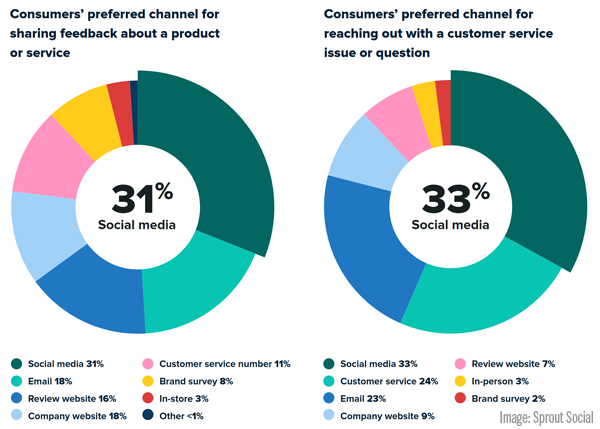 “44 percent of consumers will unfollow a brand on social because of poor service, putting a damper on brands’ growth goals,” the report warned. The Sprout Social study surfaces a fascinating distinction between what consumers and marketers believe makes for best-in-class social media performance. The most important factor among consumers — at 47 percent — was brands that offer strong customer service, while that was only the sixth most important factor to marketers, at 35 percent.
“44 percent of consumers will unfollow a brand on social because of poor service, putting a damper on brands’ growth goals,” the report warned. The Sprout Social study surfaces a fascinating distinction between what consumers and marketers believe makes for best-in-class social media performance. The most important factor among consumers — at 47 percent — was brands that offer strong customer service, while that was only the sixth most important factor to marketers, at 35 percent.
 “Brands embraced new social platforms, virtual events, and influencer marketing strategies that can open the door to new opportunities to drive brand awareness and grow new audiences,” the report suggested. A robust 68 percent of B2B marketers said they expected their digital marketing budgets to increase during the forthcoming year, with 26 percent seeing a significant budget increase ahead, according to the report data. When it comes to driving revenue, 57 percent of B2B marketers saw social media as the most effective digital marketing channel, followed by content marketing and email, each at 47 percent. Reinforcing the notion supported by the other research we’ve examined, the Ascend2 and Wpromote data showed that social media was the area of digital customer experience that had the most impact on overall strategic success, according to 57 percent of respondents — ahead of website optimization’s 47 percent and paid advertising’s 42 percent. “Whatever social platforms you use as a B2B marketer, if you prioritize the time and resources to add new social platforms to your mix, you increase the opportunity to build new audiences and further engage with your existing audience,"
“Brands embraced new social platforms, virtual events, and influencer marketing strategies that can open the door to new opportunities to drive brand awareness and grow new audiences,” the report suggested. A robust 68 percent of B2B marketers said they expected their digital marketing budgets to increase during the forthcoming year, with 26 percent seeing a significant budget increase ahead, according to the report data. When it comes to driving revenue, 57 percent of B2B marketers saw social media as the most effective digital marketing channel, followed by content marketing and email, each at 47 percent. Reinforcing the notion supported by the other research we’ve examined, the Ascend2 and Wpromote data showed that social media was the area of digital customer experience that had the most impact on overall strategic success, according to 57 percent of respondents — ahead of website optimization’s 47 percent and paid advertising’s 42 percent. “Whatever social platforms you use as a B2B marketer, if you prioritize the time and resources to add new social platforms to your mix, you increase the opportunity to build new audiences and further engage with your existing audience,"  Bringing many of these trends and tactics together, account-based marketing (ABM) — or even account based experiences (ABX), as our CEO
Bringing many of these trends and tactics together, account-based marketing (ABM) — or even account based experiences (ABX), as our CEO 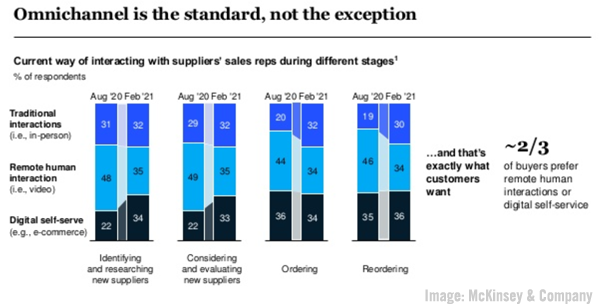 LinkedIn's*
LinkedIn's* 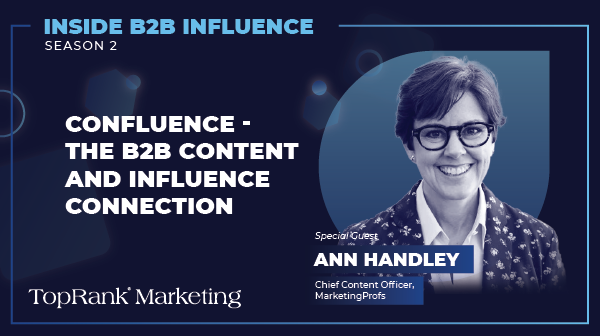
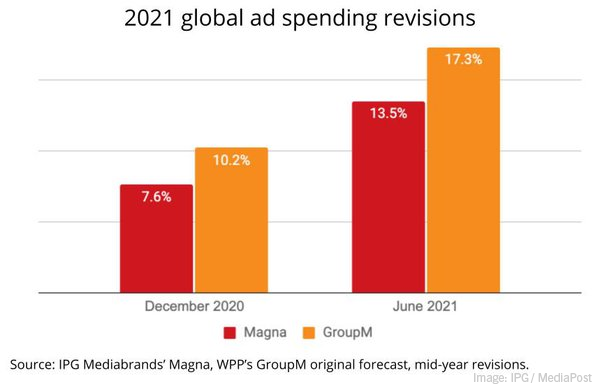
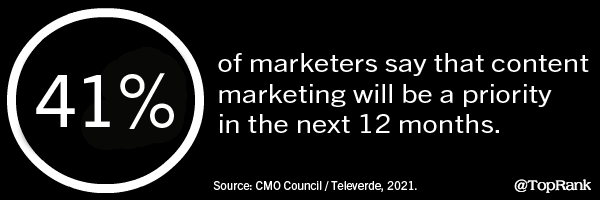 Augmented Reality Market to Hit $175B by 2026: ABI Research The global augmented reality (AR) and mixed reality (MR) market will top $175 billion by 2026, with almost 28 million smart glasses expected to ship by then, according to recently-released forecast data of interest to digital marketers.
Augmented Reality Market to Hit $175B by 2026: ABI Research The global augmented reality (AR) and mixed reality (MR) market will top $175 billion by 2026, with almost 28 million smart glasses expected to ship by then, according to recently-released forecast data of interest to digital marketers. 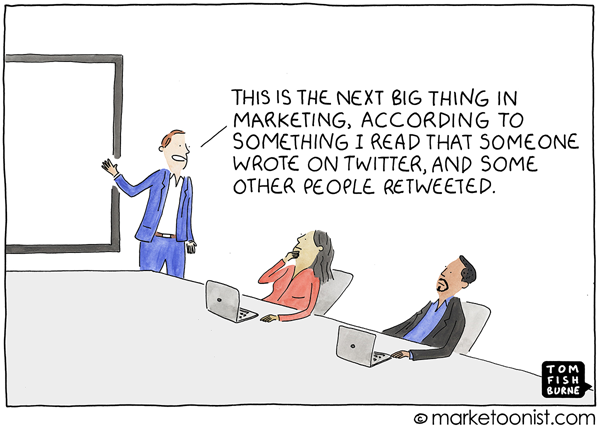 A lighthearted look at the “the next big thing in marketing” by Marketoonist Tom Fishburne —
A lighthearted look at the “the next big thing in marketing” by Marketoonist Tom Fishburne — 
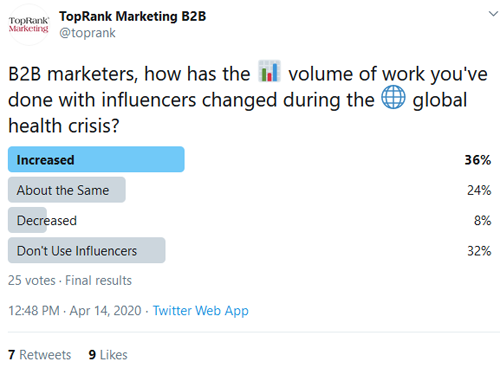 At that point relatively early in the pandemic, 36 percent of our respondents noted an increase in their use of influencers in marketing efforts.
At that point relatively early in the pandemic, 36 percent of our respondents noted an increase in their use of influencers in marketing efforts.
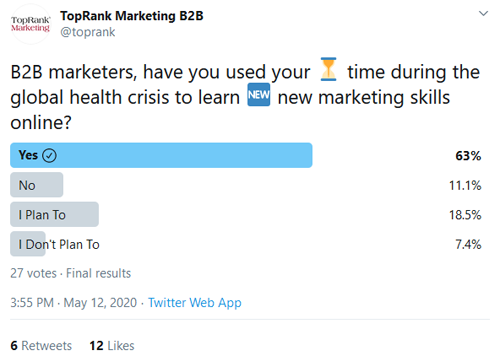
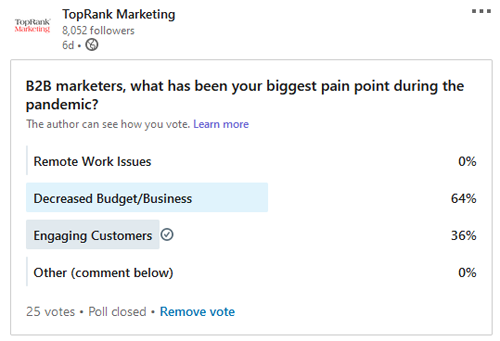
 Decreasing business or budgets was the top concern, with 64 percent of our Twitter poll respondents saying that was their biggest pandemic pain point, a sentiment shared by 46.2 percent of our LinkedIn respondents.
Decreasing business or budgets was the top concern, with 64 percent of our Twitter poll respondents saying that was their biggest pandemic pain point, a sentiment shared by 46.2 percent of our LinkedIn respondents.

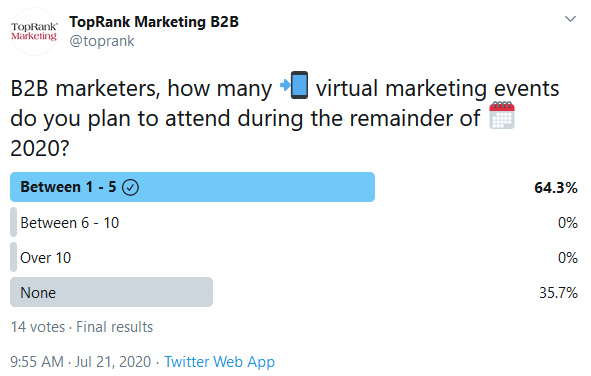 Most B2B marketers planned to attend between one and five virtual events before the end of 2020, with 11 percent noting they would attend between six and ten online events.
Most B2B marketers planned to attend between one and five virtual events before the end of 2020, with 11 percent noting they would attend between six and ten online events.

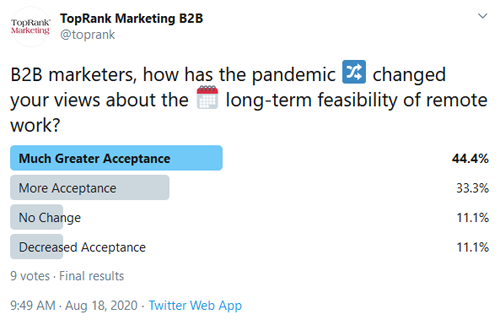 By this time, most B2B marketers had much greater acceptance when it came to the long-term feasibility of remote work than they did before the pandemic. This poll backed this notion, with over three quarters of respondents on both our LinkedIn and Twitter polls saying that they had either more acceptance or much greater acceptance of remote work as a long-term practice. Hybrid work scenarios are also very much a part of continuing conversations about the future of work, as I recently explored in “
By this time, most B2B marketers had much greater acceptance when it came to the long-term feasibility of remote work than they did before the pandemic. This poll backed this notion, with over three quarters of respondents on both our LinkedIn and Twitter polls saying that they had either more acceptance or much greater acceptance of remote work as a long-term practice. Hybrid work scenarios are also very much a part of continuing conversations about the future of work, as I recently explored in “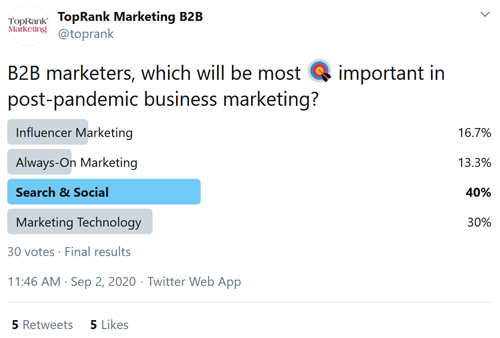
 39 percent of our LinkedIn poll takers said that always-on marketing would be the most important type of post-pandemic marketing, followed by 26 percent who said search and social, 19 percent who picked marketing technology, and 16 percent who picked influencer marketing. 40 percent of our Twitter poll respondents said that search and social will be most important, 30 percent said marketing technology, 16.7 percent picking influencer marketing, and 13.3 percent for always-on marketing. The results point to the mixed viewpoints and uncertainly surrounding just what will be the most important when the dust from the pandemic fully settles. Our own
39 percent of our LinkedIn poll takers said that always-on marketing would be the most important type of post-pandemic marketing, followed by 26 percent who said search and social, 19 percent who picked marketing technology, and 16 percent who picked influencer marketing. 40 percent of our Twitter poll respondents said that search and social will be most important, 30 percent said marketing technology, 16.7 percent picking influencer marketing, and 13.3 percent for always-on marketing. The results point to the mixed viewpoints and uncertainly surrounding just what will be the most important when the dust from the pandemic fully settles. Our own 
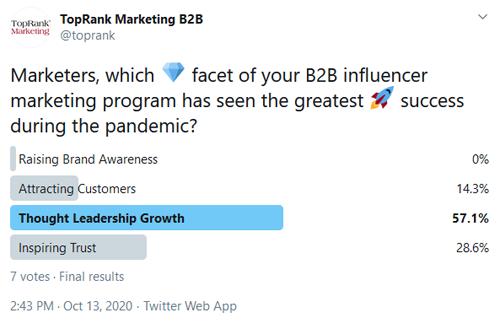 42 percent of our LinkedIn poll-takers said that inspiring trust was the area of their B2B influencer marketing program that had seen the greatest success during the pandemic, followed by thought leadership growth, raising brand awareness, and attracting customers. Among our Twitter poll-takers thought leadership growth was the top choice, followed by inspiring trust and attracting customers.
42 percent of our LinkedIn poll-takers said that inspiring trust was the area of their B2B influencer marketing program that had seen the greatest success during the pandemic, followed by thought leadership growth, raising brand awareness, and attracting customers. Among our Twitter poll-takers thought leadership growth was the top choice, followed by inspiring trust and attracting customers.

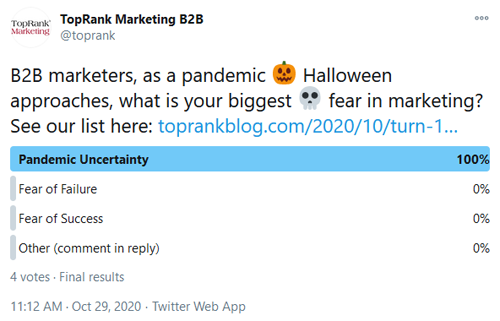 On both LinkedIn and Twitter the biggest fear was the uncertainty of the pandemic, with some also choosing the powerful fear of failure. I expanded on turning fear into success in a full article to accompany our poll, in “
On both LinkedIn and Twitter the biggest fear was the uncertainty of the pandemic, with some also choosing the powerful fear of failure. I expanded on turning fear into success in a full article to accompany our poll, in “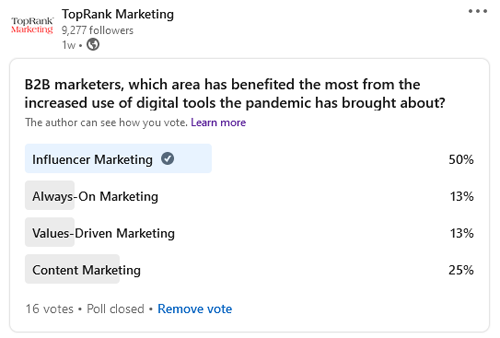
 Influencer marketing was seen by both our LinkedIn and Twitter poll-takers as the greatest beneficiary when it came to areas that grew during the pandemic. Content marketing was the second choice, followed by always-on and then values-driven marketing.
Influencer marketing was seen by both our LinkedIn and Twitter poll-takers as the greatest beneficiary when it came to areas that grew during the pandemic. Content marketing was the second choice, followed by always-on and then values-driven marketing.
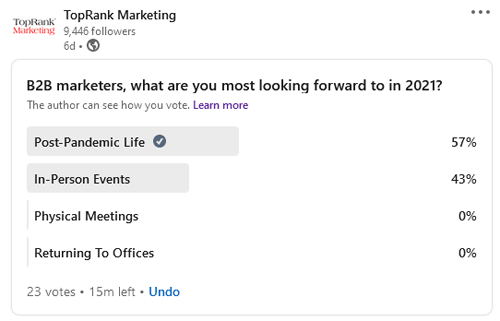
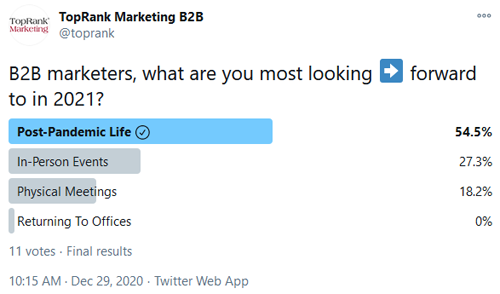 What were B2B marketers most looking forward to in 2021? Post-pandemic life was by far the top choice of both our Twitter and LinkedIn poll-takers, followed by in-person events and physical meetings.
What were B2B marketers most looking forward to in 2021? Post-pandemic life was by far the top choice of both our Twitter and LinkedIn poll-takers, followed by in-person events and physical meetings.

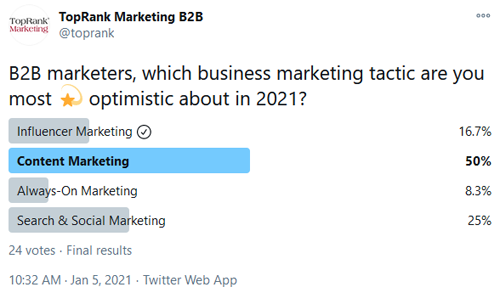 When we asked which business marketing tactic poll-takers were most optimistic about, on LinkedIn 36 percent chose content marketing, 29 percent search and social, 21 percent influencer marketing, and 14 percent who selected always-on marketing. Among our Twitter poll-takers some 50 percent chose content marketing, 25 percent search and social, followed by 16.7 percent who picked influencer marketing, and 8.3 percent who chose always-on marketing.
When we asked which business marketing tactic poll-takers were most optimistic about, on LinkedIn 36 percent chose content marketing, 29 percent search and social, 21 percent influencer marketing, and 14 percent who selected always-on marketing. Among our Twitter poll-takers some 50 percent chose content marketing, 25 percent search and social, followed by 16.7 percent who picked influencer marketing, and 8.3 percent who chose always-on marketing.
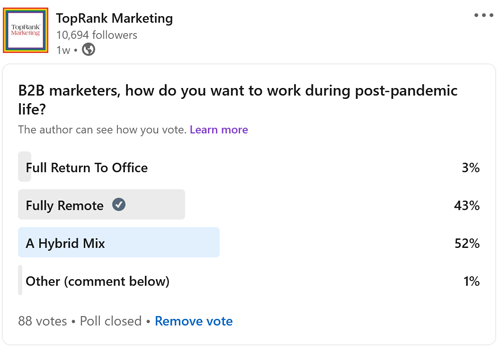
 Among 88 poll takers on LinkedIn, 52 percent said that wanted a hybrid mix of remote and office work types, 43 percent wanted fully remote work, and just 3 percent a full return to office work. On Twitter, 75 percent of B2B marketers preferred a hybrid scenario, 15 percent fully remote, and 10 percent a full return to the office.
Among 88 poll takers on LinkedIn, 52 percent said that wanted a hybrid mix of remote and office work types, 43 percent wanted fully remote work, and just 3 percent a full return to office work. On Twitter, 75 percent of B2B marketers preferred a hybrid scenario, 15 percent fully remote, and 10 percent a full return to the office.